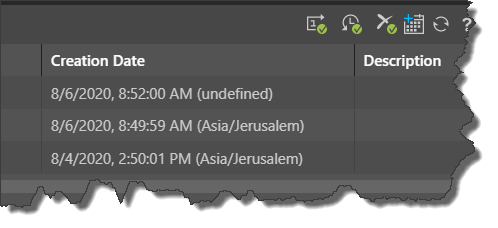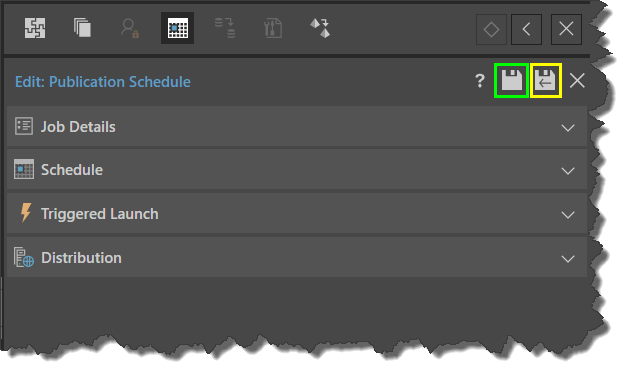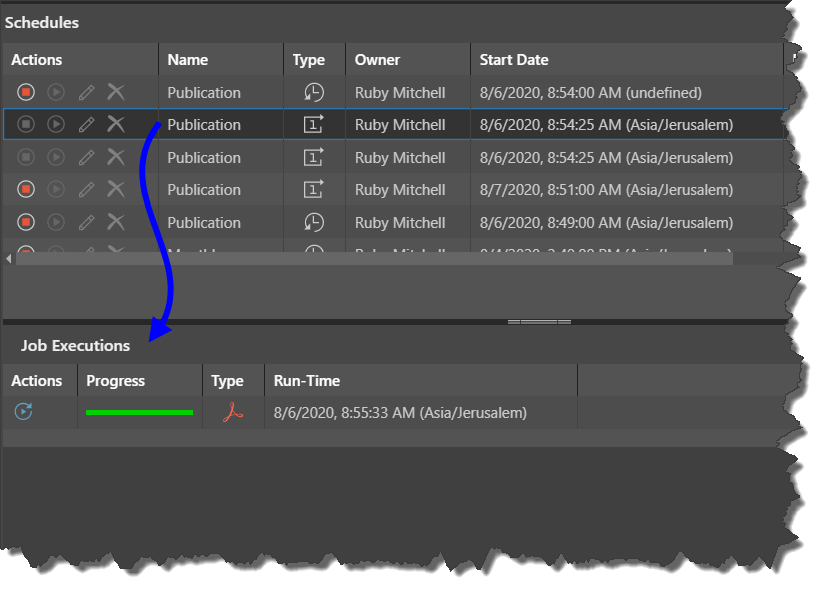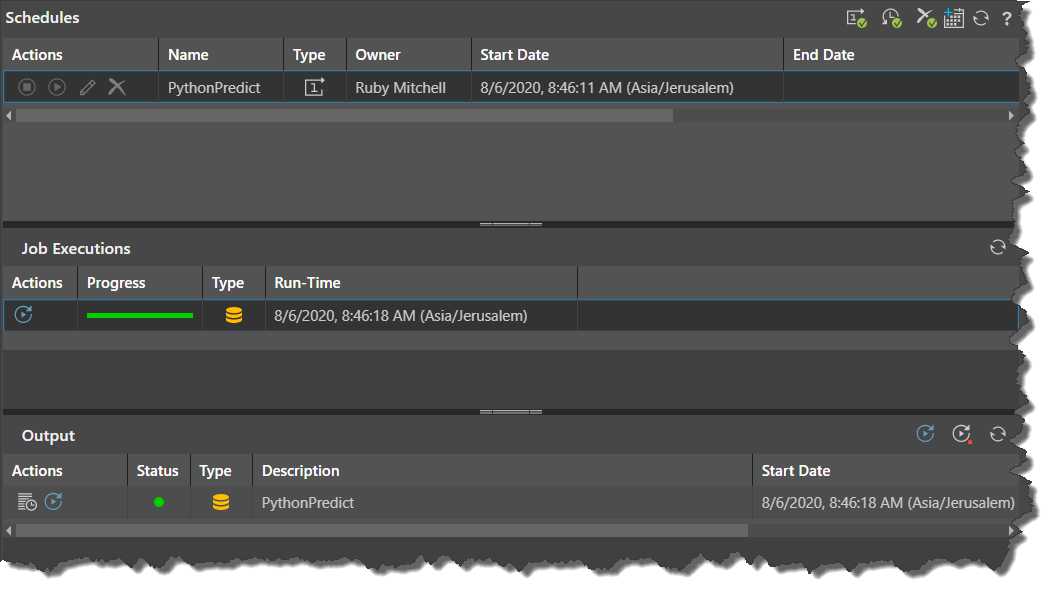Users can create and edit schedules for both models and publications.
- Publication schedules are used to auto-run and distribute publications to a list of users, either via the bulletin board or via email.
- Model schedules are used to auto-run the processing for data flows and data models.
The schedules for both Model and Publish can be created from within each app, when the relevant item is open in the App Tab interface. However, schedules can also be created and managed from the relevant content item's Actions Panel .
Users can also build and edit subscription schedules for data discoveries and presentations. Subscription schedules are used to auto-run and distribute data discoveries and presentations to a static list of users via the bulletin board or via email.
Scheduling of models and publications is not available in the Community Edition.
Accessing Schedules and Subscriptions
To access the schedules for both Publish and Model content (other than from inside each app), click the Scheduling button on the item's Actions Panel (green arrow below) or choose "Schedule" from the item's context menu.
The schedule tools can only be viewed for one item at time. If multiple objects are selected in the content manager the options are unavailable.

Alternatively, for discoveries and presentations open the Subscribe tab.
The Scheduling or Subscribe tab of the content item's Actions Panel exposes several capabilities:
- A list of existing schedules that have been configured for the model or publication are presented. For each existing schedule in the list:
- Actions allow users to stop, start, edit, or delete a content item's schedule.
- View a list of job executions for a given schedule (these are the instances when a schedule was run in the past)
- For each job, view the list of outputs.
- For publications: download the rendered report or see its Print & Export Summary
- For models: see the progress report for the model execution
- For each job, view the list of outputs.
The tab also has buttons at the top that lets users create a new schedule for a given content item.
Note: when subscribing to content and distributing it to other users, the subscription runs as the initiating user. The recipient to whom the subscription is distributed receives the same data as the initiating user. This means the recipient may see unsecured data.
If you want to distribute data dynamically, sending different data from the same report to different users, this is done by configuring dynamic distribution of publications. In this case, the recipient will only see data for which they have permissions.
Schedules/ Subscriptions List
When you open the Scheduling or Subscriptions tab, you will be presented with a list of schedules for the selected item. By default, the listing shows "live schedules" only - which are current recurring schedules that have not ended or one-off schedules that need to run or completed running in the last 24 hours.
At the top of the list are several options (blue highlight below). From left to right these options are:
- Show/ Hide old one offs: show or hide old on-off (non-recurring) schedules (hidden be default).
- Show/ Hide inactive recurring: show or hide recurring schedules that have been stopped (hidden by default).
- Show/ Hide deleted: show or hide deleted schedules (hidden by default).
- New schedule: create a new schedule.
- Refresh: refresh the list of schedules.

For each schedule in the list you will see several columns; scroll across to see all columns.

Each listing will display the following columns:
- Actions: from the actions column, you can stop, start, edit, or delete a schedule.
- Name: the name of the schedule.
- Type: the icon indicates the schedule type; either a one-off or recurring.
- Owner: the user who owns the schedule.
- Start Date: the sate and time at which the schedule started or will start.
- End Date: the date and time at which the schedule ended or will end (if the schedule is recurring and an end time and time was defined).
- Creation Date: the date and time at which the schedule was created.
- Description: the schedule's description (if one was given).

Edit a Schedule
All schedules can be edited to adjust their settings and configuration. When editing an existing schedule, there are 2 options for saving changes to the schedule:
- Save: click the Save icon (green highlight below) to save changes to the schedule without running it.
- Save & Run: click the Save & Run icon (yellow highlight) to save changes and run the scheduling job.

Job Executions
Each time a schedule is run, its creates a "job". To view the historical list of job executions for a particular schedule, click on the schedule item in the list to show all its current and previous job executions. Each listing in the job executions will display the following columns:
- Actions: the option to re-run the entire job.
- Progress: shows the progress of the job, showing the percentage of separate tasks and their status
- blue indicates the number of tasks that are currently waiting in queue to be processed
- yellow is the number of tasks that are currently processing,
- red is the number of tasks that have failed
- green is the number of tasks that completed successfully.
- Type: the file output type (relevant for publications only)
- Run-Time: the date and time that the job was run.

Outputs
Each job produces one or more "outputs".
- For discoveries, presentations, and publications the outputs are each of the rendered reports - and usually there are multiple rendered outputs.
- For models, the output is simply the result of the data flow and model processing - which is therefore only a single output.
You can view the output of a specific job execution by clicking on the job's listing. This will open the Output panel for the selected job execution (blue arrow below). The output panel has slightly different functionality based on the content type.
Discoveries, Presentations, and Publications
The Output list for discoveries, presentations, and publications displays the following columns:
- Actions: from the Actions column you can download the publication, view the Print & Export Summary, or re-run the specific task.
- Status: displays the status of the job execution's output.
- red - a specific task that failed
- orange - a specific task that partially failed
- green - a specific task that was fully successful
- Type: the output type (PDF, Word, Excel etc)
- Description: the name of the schedule job.
- Start Date: the date and time that the job execution's output started running.
Above the list, there are buttons to rerun all tasks (which is the same as rerunning the entire job as described above) or rerun only those tasks that failed (yellow box below).

Models
The Output list for model schedules displays the similar columns as listed above. However, the Actions column presents 2 options:
- ETL Progress: open the ETL Progress dialog to see details of the status of each component of the ETL that was run.
- Re-run: re-run the model task.
